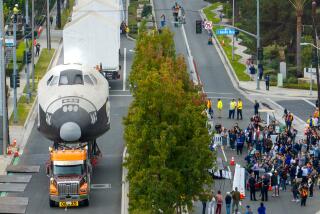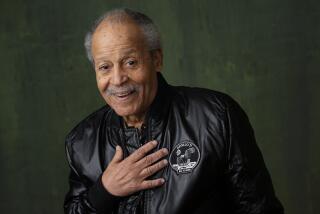Star Power : Engine Builders Look Back on Shuttles’ 1st Decade
Ten years ago today, America’s space program took a giant leap into history with the launching of the space shuttle Columbia.
The inaugural flight of the world’s first reusable spacecraft lasted only 54 hours and 20 minutes. But it will forever be a source of great pride for Simi Valley residents Rod Reed and Joe O’Brien, who helped get it off the ground.
Both men work for the Rocketdyne division of Rockwell International Inc. in Canoga Park. The company, one of the world’s largest defense and aerospace contractors, is under contract to NASA to develop and build the main engines for all of the space shuttle flights.
Reed, 49, is manager of final shuttle engine assembly, and O’Brien, 57, is lead checkout mechanic.
The shuttle engines are unique, they said, because they are interchangeable between spacecraft. The engines--of which there are now nine in service--took 10 years to develop at a cost of about $40 million each.
About the same size as a large automobile, the shuttle engines are designed to deliver the equivalent of 37 million horsepower.
“Watching that first launch gave us a real sense of accomplishment,” said Reed, who along with O’Brien watched the event on a television monitor at work.
“There was a lot of yelling and screaming around here,” he said. “It was a real heart-throbber.”
Reed and O’Brien said they met John Young, commander of the Columbia, and Bob Crippen, the pilot, a few months before the flight when the astronauts visited Rocketdyne’s Canoga Park plant.
O’Brien said he still has the two $1 bills that the astronauts autographed for him.
“I keep them in a safety-deposit box at the bank,” he said.
Since the first Columbia flight 10 years ago, there have been 38 space shuttle missions that have carried 125 men and women into space. The most recent flight ended Thursday morning with the successful landing of the shuttle Atlantis at Edwards Air Force Base near Lancaster.
For Rocketdyne officials, the impact of the Columbia flight is equaled only by that of the Challenger disaster on the morning of Jan. 27, 1986.
The Challenger exploded moments after takeoff at Cape Canaveral, Fla., as millions of television viewers watched in horror.
All seven crew members were killed, including Sharon Christa McAuliffe, a New Hampshire schoolteacher who was the first private citizen selected to fly on the shuttle.
Rocketdyne’s engines were not the cause of the explosion. Investigators blamed a faulty seal on one of the shuttle’s two solid rocket boosters manufactured by Utah-based Morton Thiokol. The boosters provide the initial thrust for liftoff while the shuttle’s main engines carry it into orbit.
“I was working on an engine when they told me” about the Challenger explosion, O’Brien said. “I couldn’t believe it. Nobody wanted to do anything. We all just wanted to cry.”
Betty McLaughlin, another Simi Valley resident who works as a publicist for Rocketdyne, also recalled the day.
“We were all just numbed,” she said. “Everyone ran out of their office trying to find out what happened. It was very dramatic and emotional.”
But O’Brien, who has been with Rocketdyne for 34 years, said the accident did not change his opinion about the space shuttle program.
“I was sad and upset,” he said, “but my feeling was that we had to keep going.”
Reed agreed, saying the space shuttle will soon make it possible to build a space station.
“Someday we’re going to go to the stars,” Reed said. “We’re laying the foundation for that right now.”
Shuttle IS HOME: Atlantis lands after day delay. A3
More to Read
Sign up for Essential California
The most important California stories and recommendations in your inbox every morning.
You may occasionally receive promotional content from the Los Angeles Times.










